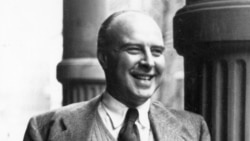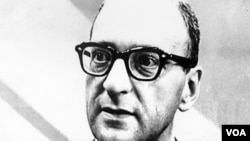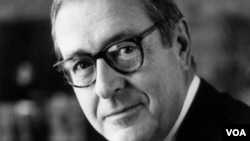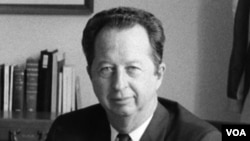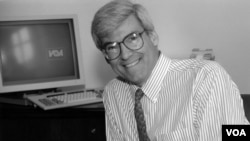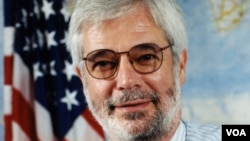In 1939, the American playwright Robert Sherwood, who would become a speechwriter for President Franklin Roosevelt and later, the "father of the Voice of America," predicted the impact of international broadcasting when he said:
"We are living in an age when communication has achieved fabulous importance. There is a new decisive force in the human race, more powerful than all the tyrants. It is the force of massed thought--thought which has been provoked by words, strongly spoken."
In that year, the United States was the only world power without a government-sponsored international radio service. The Netherlands had been the first country to direct regularly-scheduled broadcasts beyond its own borders, inaugurating shortwave programming to the Far East in 1927. Seeing radio as an instrument of foreign policy, the Soviet Union built a radio center in Moscow and was broadcasting in 50 languages and dialects by the end of 1930. Italy and Great Britain started their respective "empire services" in 1932, followed by France the next year. Nazi Germany built a massive network of transmitters in 1933 and began to beam hostile propaganda into Austria. In the same year Berlin started shortwave broadcasts to Latin America. Meanwhile, Japan was using radio to promote its national ambitions in the Far East.
Despite the efforts of many prominent figures, including New York Congressman Emmanuel Celler (who introduced bills in 1937, 1938 and 1939 to create a government station that could respond to German propaganda), the United States entered the 1940s with no plans to establish an official U.S. presence on the international airwaves.
The United States' shortwave resources consisted of just over a dozen low-powered, commercially owned and operated transmitters.
In 1941, several of these private transmitters were leased by the U.S. Coordinator for Inter-American Affairs (CIAA) to broadcast to Latin America. In mid-1941, President Roosevelt established the U.S. Foreign Information Service (FIS) and named speechwriter Sherwood as its first director. Driven by his belief in the power of ideas and the need to communicate America's views abroad, Sherwood rented space for his headquarters in New York City, recruited a staff of journalists and began producing material for broadcast to Europe by the privately-owned American shortwave stations. Sherwood also spoke with officials in London about the prospect of relaying FIS material over the facilities of the British Broadcasting Corporation (BBC).
With Japan's attack on Pearl Harbor and Germany's declaration of war against the United States, Sherwood moved into high gear. He asked John Houseman, the theatrical producer, author and director, to take charge of FIS radio operations in New York City.
In December 1941, FIS made its first direct broadcasts to Asia from a studio in San Francisco. On February 1, 1942— less than two months after the United States entered World War II--FIS beamed its first broadcast to Europe via BBC medium- and long-wave transmitters. Announcer William Harlan Hale opened the German-language program with the words: “We bring you Voices from America. Today, and daily from now on, we shall speak to you about America and the war. The news may be good for us. The news may be bad. But we shall tell you the truth.”
- LET THE TRUTH BE TOLD
- THE POST-WAR BLUES
- A VOICE OF FREEDOM OR FEAR
- A NEW BEGINNING
- THE STAMP OF APPROVAL
- ACCEPTING THE CHALLENGE
- GETTING DOWN TO BUSINESS
- NO BETTER TIME THAN THE PRESENT
- THE CHANGING FACE OF INTERNATIONAL BROADCASTING
- CONSOLIDATION OF U.S. INTERNATIONAL BROADCASTING
- INNOVATIONS FOR A NEW CENTURY
- AMERICANS ARE FREE TO WATCH, LOG ON AND READ
- LOOKING TO THE FUTURE
From the beginning, VOA promised to tell its listeners the truth, regardless of whether the news was good or bad. As VOA's first director, John Houseman, said later, "In reality, we had little choice. Inevitably the news that the Voice of America would carry to the world in the first half of 1942 was almost all bad. As Japanese invasions followed one another with sickening regularity and the Nazi armies moved ever deeper into Russia and the Near East, we would have to report our reverses without weaseling. Only thus could we establish a reputation for honesty which we hoped would pay off on that distant but inevitable day when we would start reporting our own invasions and victories."
By June 1942, VOA was growing rapidly and had a new organizational home--the Office of War Information (OWI). Twenty-three transmitters had been constructed and 27 language services were on the air when the Allied summit took place in Casablanca.
As the war drew to a close, however, many of VOA's broadcast services were reduced or eliminated. Then in late 1945, a State Department-appointed committee of private citizens chaired by Columbia University professor Arthur McMahon advised that the U.S. government could not be "indifferent to the ways in which our society is portrayed to other countries." Consequently, on December 31, 1945, the VOA's and CIAA's broadcast services to Latin America were transferred to the Department of State, and Congress reluctantly appropriated funds for their continued operation in 1946 and 1947.
The reluctant support for international broadcasting disappeared in 1948. That year, Members of Congress were heavily influenced by the escalation of the Cold War and hostile international broadcasting by the Soviet Union and Soviet-controlled countries. The Berlin Blockade in 1948 confirmed the need for an American radio voice to the world. The enactment of the Smith-Mundt Act that year permanently established America's international informational and cultural exchange programs, a function VOA had already been carrying out for the past six years on its own.
For the next two years, officials in the U.S. government debated the proper role of America's official international broadcasting service. Was it to report the news and reflect America, or was it to be used as an instrument of U.S. foreign policy and as a "weapon" against the Soviet Union? Congress saw it increasingly as fulfilling the latter role. With the outbreak of the Korean War in 1950, VOA added new language services and developed plans to construct transmitter complexes on both the east and west coasts of the United States.
In early 1953, Senator Joseph McCarthy chaired several weeks of hearings to investigate programming and engineering practices at VOA and allegations that there were "subversives on the staff guilty of negligence favoring communism." The inquiry also examined management practices and plans to build new VOA transmitters. While the charges of subversive activity were never proven, widespread dismissals and resignations followed. In the wake of the congressional hearings, VOA's budget was reduced, the transmitter construction program was halted and a number of language services were terminated.
Even before the McCarthy hearings ended, however, a commission appointed by President Dwight Eisenhower had begun a review of U.S. foreign information activities, including the Voice of America. The commission, chaired by former President Herbert Hoover, concluded that these programs should be separated from the Department of State. On August 1, 1953, the United States Information Agency was established, and VOA became its single largest element. A year later, VOA moved its headquarters from New York City to its present site on Independence Avenue, SW, not far from the U.S. Capitol in Washington, DC.
The crises in Hungary and Suez, the beginnings of American-Soviet summitry and the dawning of the space age in the late 1950s and the early 1960s offered new opportunities for VOA to provide reliable and comprehensive reporting of world events. New and creative programming reflecting America was introduced. In 1959, VOA inaugurated Special English--slow-paced, simplified English broadcasts--to facilitate comprehension for millions of listeners.
In 1960, USIA Director George Allen endorsed the VOA Charter that had been drafted by VOA staff members between 1958 and 1959 to put in writing a formal statement of principles that would govern VOA broadcasts. The Charter said in part that:
(1) VOA will serve as a consistently reliable and authoritative source of news. VOA news will be accurate, objective and comprehensive.
(2) VOA will represent America, not any single segment of American society, and will therefore present a balanced and comprehensive projection of significant American thought and institutions.
(3) VOA will present the policies of the United States clearly and effectively, and will also present responsible discussions and opinion on these policies.
In July 1976, Representative Bella Abzug and Senator Charles Percy sponsored legislation making the VOA Charter Public Law 94-350. President Gerald Ford signed the legislation on July 12, 1976.
A complete roster of the men and women who formed and nourished the Voice of America in its infancy, John Houseman recalled, "would reveal a collection of U.S.-born and foreign luminaries in their various fields--journalists, publishers, executives, actors, directors, economists, philosophers, poets, artists, musicians, educators and financiers--of such celebrity in their past and future lives that it is almost impossible to believe they were all ever assembled under one roof.'"
Twenty-five years later, former Director John Chancellor wrote, "There's a peculiar sort of ramshackle excellence about the Voice of America. I came to work there with the standard conceptions and misconceptions of an outsider. I did think of it as a calm and dignified group of broadcasters. To my surprise, I found that I had misjudged the spirit--indeed, the clamor--that exists inside the Voice. It was like walking into a stately building to find the residents holding up the walls with broomsticks while carrying on a terrific argument. There is a fine, antic sense of madness about the place and after a year and a half of taking my turn at the broomstick, I view the Voice and its employees with a feeling of pride and affection."… He continued, "They are, to a remarkable degree, people of spirit and intelligence, whose passion is to represent the United States in the best possible manner."
In the 1960s and 1970s, VOA took giant steps toward becoming the world's leading international broadcaster. During the tenure of Director Henry Loomis from 1958 to 1965, the VOA Charter was written, and technical facilities and programming for every part of the world were expanded.
When NBC newsman John Chancellor took up the reins in 1965, he promised that VOA broadcasts "would swing a little." VOA began to produce livelier and more creative programs in both English and its language broadcasts. News-gathering resources were increased, making possible more live, on-the-scene reporting. In 1969, when Neil Armstrong set foot on the moon, nearly 800 million people were tuned to the Voice of America or to the hundreds of stations around the world that were relaying VOA's live coverage. In 1977, VOA became the first international broadcaster to use a full-time satellite circuit to deliver programming from its own studios to an overseas relay station--in this case, the VOA Arabic programs from Washington to the Voice transmitters on the Greek island of Rhodes.
During Kenneth Giddens' tenure as director from 1969 to 1977, the longest of any VOA director, VOA dramatically enhanced its credibility through its straightforward reporting of two events that traumatized the nation--the war in Vietnam and the constitutional crises posed by Watergate. VOA's reporting not only drew praise from the American press, but also from listeners in every part of the world, as tens of thousands wrote to express their admiration for VOA's comprehensive and objective coverage.
The cessation of Soviet- and Soviet-bloc jamming, which took place throughout the Cold War; an expanding audience in China; and the introduction of new and expanded programming for listeners in Iran, Afghanistan and Poland were opening up vast new audiences for VOA. As Giddens had predicted, however, VOA's potential to reach an ever-increasing number of the world's citizens was being handicapped by insufficient resources. As the 1970s came to an end, the gap between VOA's extensive programming requirements and the level of funding had led to serious deficiencies in both personnel and facilities. Almost every language service was short-staffed. It was not unusual to find translator-announcers working two and three weeks without a day off. VOA's antiquated studios and master control complex were breaking down with increasing frequency despite the best efforts of a dedicated technical staff skilled in fabricating spare parts no longer manufactured.
Listeners in many parts of the world were complaining that VOA signals sounded weak and distorted. By the early 1980s, many VOA transmitters were more than thirty years old and some were over forty. Few were capable of producing the 500,000-watt signals being generated by VOA's leading competitors. And the competition itself was increasing. In the mid-1980s, some 160 stations were crowding the international spectrum with upwards of 25,000 hours of programming a week.
NO BETTER TIME THAN THE PRESENT
In 1983, VOA launched a $1.3 billion program to rebuild and modernize VOA programming and technical capabilities. However, due to government-wide budget constraints at the time, VOA was forced to reduce the funds devoted to this project. Despite less funding, major new and upgraded radio transmission facilities were completed in Botswana, Morocco, Thailand, Kuwait and Sao Tome over the next several years. In Washington, nineteen "state-of-the-art" studios were constructed, a new Master Control complex was installed and a Network Control Center was built to coordinate and direct VOA's domestic and overseas relay transmitter stations.
At the same time radio facilities were being upgraded around the world, USIA took on another directive from the president - to introduce interactive television to the world using growing satellite systems. At the end of 1983 VOA’s sister agency, WORLDNET Television, was born, with a two-hour interactive broadcast connecting studios in Barbados, New York, and Washington DC, with embassies in Bonn, London, the Hague, Rome, and Brussels.
In 1985, Congress established a special service to Cuba known as Radio Marti, which broadcast news of that country. Although Radio Marti followed VOA editorial guidelines, it operated separately from the Voice and its own Washington studios. A television service, TV Marti, went on the air in 1990, and in 1996, Radio and TV Marti began to transfer their operations to Miami, a move that would be completed by 1998.
VOA Mandarin and Cantonese broadcasts were increased in 1989 to bring tens, and perhaps hundreds, of millions of Chinese listeners accurate reports of the pro-democracy movement that filled Beijing's Tiananmen Square and the streets of dozens of Chinese cities. In the fall and winter, VOA reported the historic changes that were sweeping Eastern Europe and the Soviet Union--changes that some have ascribed, at least in part to the Voice and other western international broadcasters. And with the arrival of the 1990s, VOA Russian covered the attempted August 1991 coup against then Soviet leader Mikhail Gorbachev and the dissolution of the Soviet Union at the end of the same year.
Following the formation of the Commonwealth of Independent States (C.I.S.) and the collapse of communist governments throughout Eastern Europe, VOA continued a daily flow of news and information to the region. All of these newly formed governments have been trying, with varying degrees of success, to embrace democracy and its underlying principles. East European leaders such as the Czech Republic's Vaclav Havel asked the West to help them understand how to establish the infrastructure of democratic institutions. VOA responded with programming designed to explain how democracy works in the West and how market economies function.
While there was a great need to maintain VOA broadcasts to the C.I.S. and Eastern Europe, the Voice of America continued to provide news and information to people in other parts of the world. On March 25, 1991, VOA launched a 15-minute Tibetan program, which the Chinese government promptly started to jam. Kurdish-language broadcasts to listeners in Iraq and Iran went on the air on April 25, 1992. Somali broadcasts started on December 27, 1992, but were discontinued shortly after the withdrawal of all U.S. forces from that country.
In response to the breakup of the former Yugoslavia in 1991 into several republics, VOA divided its Yugoslav Service into two separate language services--Croatian and Serbian--on February 21, 1993. Both services expanded their broadcast hours to the region and along with VOA's Slovene Service, maintained a constant flow of news and information to the listeners in the Balkans. A Bosnian Service was added in 1996 and a Macedonian Service in 1999.
VOA also established a network of Croatian and Serbian local radio stations to carry VOA-produced programming. On October 1, 1996, Radio 101 FM began to carry VOA Croatian, making it the first station in Zagreb to include programming from an international broadcaster in its schedule. That same year, VOA Serbian increased its daily broadcasts to two and a half hours when it added a 30-minute, medium wave radio broadcast. By the end of 1996 when anti-Milosevic demonstrations erupted, VOA Serbian launched its 30-minute TV show, Open Studio.
A live 15-minute VOA Bosnian "feed" service, which was transmitted to local radio stations via satellite, was established on April 22, 1996. VOA later increased the Bosnian-language program to 30 minutes and launched the direct TV broadcasts in Bosnian late the same year.
When the Milosevic government in Belgrade banned broadcasts of Radio B-92 and other independent local radio stations on December 3, 1996, VOA included reports on its newscasts from stringers in Belgrade, many of whom also worked for Radio B-92. Realizing that it could not stifle the flow of information, the Milosevic government allowed Radio B-92 to resume broadcasts two days later on December 5. On the same day that B-92 resumed its broadcasts, VOA began pilot simulcasts on radio and TV of its 11:30 p.m. (Serbian local time) newscast. Serbian independent TV stations with a potential viewership of four million carried the program.
On July 15, 1996, the Voice of America added broadcasts in Tigrigna and Afan Oromo--its 49th and 50th languages--for listeners in Ethiopia and Eritrea. Tigrigna is one of the working languages of the independent nation of Eritrea, and the largest ethnic group in Ethiopia speaks Afan Oromo. The two languages joined VOA Amharic, which has been on the air since 1982.
On the same day, VOA introduced Kirundi- and Kinyarwanda-language programming for listeners in conflict-ridden Central Africa. VOA, which was already broadcasting in English, French and Swahili to the region, increased its audience. With funding from the U.S. Agency for International Development, the two services--VOA's 51st and 52nd languages--went on the air on July 15, 1996 with a 30-minute weekday program. The following November they expanded the show to seven days a week and one month later increased their Saturday and Sunday programs to one hour.
VOA also established refugee hotlines in both the Balkans and Central Africa in 1996. VOA Serbian and Croatian launched their hotline on August 14, and Kirundi and Kinyarwanda on November 30. VOA language broadcasts to both regions offered listeners a means through which they could be reunited with friends and family separated by war and personal hardship.
When citizens in Tirana and other Albanian cities protested the proliferation of illegal financial schemes in February 1997, VOA Albanian broadcasts were a prime source of news for the people of that country. By March 1997, the crisis had deteriorated into civil conflict, and the Albanian government cut off VOA Albanian program feeds to local affiliate stations in Tirana, Elbasan, Gjirokaster, Shkoder and Kukes for a short time. VOA expanded its broadcast hours both on shortwave and medium wave at the height of the crisis to provide the maximum news possible to the people of Albania.
In 1997, an agreement signed between the International Broadcasting Bureau and Asia Satellite Telecommunications Company (AsiaSat) gave the Voice of America and other U.S. government civilian international broadcasters access to AsiaSat 2, a satellite with a footprint reaching more than sixty percent of the world's population. By satellite, VOA, WORLDNET Television and Film Service, Radio Free Asia and Radio Free Europe/Radio Liberty, provided 24-hour, seven-day-a-week service to listeners and viewers in more than 53 countries in Asia, the Middle East, Australia and much of the Commonwealth of Independent States. Affiliated stations and listeners and viewers using small satellite dishes could receive stereo radio and television programming.
THE CHANGING FACE OF INTERNATIONAL BROADCASTING
Starting in 1990, all U.S. government international broadcasting services began to work more closely together. That year the U.S. Information Agency, VOA's parent Agency, established the Bureau of Broadcasting to consolidate its three programming services--the Voice of America, WORLDNET Television and Film Service and Radio and TV Marti--into one cohesive and efficient broadcasting element, supported by a single Office of Engineering and Technical Operations.
In 1991, the Bureau created the Office of Affiliate Relations and Audience Analysis (renamed the Office of Affiliate Relations and Media Training in 1996) to establish and maintain a network of "affiliated" radio and TV stations around the globe that would broadcast VOA- and WORLDNET-produced programs. Today, more than 3,500 radio, TV, and digital media outlets received content from VOA and its sister media organizations.
The Office of Business Development was established in 1994 to work with the private sector on a wide range of ventures, including the possible privatization of VOA language services, procurement of corporate underwriting for broadcasts, co-productions with major broadcast networks and fundraising from various foundations. (These initiatives benefited not only VOA, but also WORLDNET Television and Film Service and Radio and TV Marti.) From 1994 through 1996, the office raised $4 million.
CONSOLIDATION OF U.S. INTERNATIONAL BROADCASTING
U.S. government international broadcasting was consolidated even further when President Clinton signed the International Broadcasting Act (Public Law 103-236) on April 30, 1994. The legislation established the International Broadcasting Bureau (IBB) within the U.S. Information Agency (USIA) and created a Broadcasting Board of Governors (BBG) with oversight authority over all non-military U.S. government international broadcasting. The Voice of America, WORLDNET Television and Film Service and Radio and TV Marti--the three federally-funded services of the former Bureau of Broadcasting--comprised the IBB. The bipartisan BBG included the USIA Director (ex officio) and eight members appointed by the President and confirmed by the Senate. The first Broadcasting Board of Governors was sworn in on August 11, 1995.
The BBG provided oversight for VOA, the WORLDNET Television Service and Radio and TV Marti, as well as two grantee international broadcast services--Radio Free Europe/Radio Liberty (RFE/RL) and Radio Free Asia (RFA). (RFA was established under the 1994 legislation.) RFE/RL and RFA are private, non-profit corporations that receive annual congressionally-appropriated grants from the Broadcasting Board of Governors.
The International Broadcasting Act also centralized the Office of Engineering within IBB, making it responsible for planning and maintaining transmission facilities for VOA, WORLDNET and Radio and TV Marti as well as Radio Free Europe/Radio Liberty and Radio Free Asia. Transmitter sites that had formerly broadcast RFE/RL programs to the former Soviet Union and Eastern Europe were integrated into a single network operated by the IBB Engineering.
In 1998, the Foreign Affairs Reform and Restructuring Act abolished the U.S. Information Agency and made the Broadcasting Board of Governors an independent entity with the mandate to provide oversight for all U.S. government-supported international broadcasting. This included the Voice of America, WORLDNET Television and Film Service, Radio and TV Marti, Radio Free Europe/Radio Liberty, and Radio Free Asia.
In 2002, the Arabic-language Radio Sawa, which means “Together,” was established to reach audiences in the Middle East, particularly the younger generation. Its format was a mix of contemporary American and Middle East artists, along with newscasts broadcast on the quarter hour so that they would not compete with newscasts in the region. Two years later, Television Alhurra was established. Currently, Alhurra broadcasts under the Middle East Broadcasting Networks (MBN), which is funded through congressionally-appropriated grants from the U.S. Congress through the United States Agency for Global Media (USAGM), formerly known as the BBG.
Today, the Voice of America is part of the independent USAGM as well as Radio and TV Marti, Radio Free Europe/Radio Liberty, Radio Free Asia, and the Middle East Broadcasting Networks. The USAGM serves as a firewall to protect the independence of U.S. civilian international broadcasting, although at the end of 2016, Congress passed legislation that abolished the nine-member bipartisan board, which had provided guidance and oversight, and replaced it with a five-member board with an advisory role. A Chief Executive Officer now oversees the day-to-day operations of the agency.
Although historically known solely as an international radio broadcaster, VOA began to simulcast programs on TV and radio in the mid-1990s. The first, "China Forum TV," aired on September 18, 1994. This one-hour Mandarin telecast was beamed into the Peoples Republic of China by satellite. Two years later, VOA's Arabic Branch teamed up with WORLDNET Television Service and the Middle East Broadcasting Centre (MBC) in London to launch "Dialogue with the West." The success of these two programs encouraged VOA, with the assistance of WORLDNET Television, to build the new TV Studio 47 at its headquarters. The first program, a Farsi simulcast, was telecast on October 18, 1996. Since the first Farsi program, VOA has aired simulcasts in Arabic, English, Farsi, Mandarin and Serbian; VOA Russian and Thai services prerecorded programs for local stations in their respective countries.
In 1996 the Office of Engineering and Technical Operations also began a multi-million dollar program to transition the VOA’s broadcast production infrastructure from analog to digital operations. The multi-year program launched a series of improvements which developed a digital news management capability and transitioned VOA’s radio broadcast production systems from reel-to-reel tape to digital.
The official WORLDNET merger with VOA in 2004, completed the integration of TV and Radio production within Services that had been percolating within the VOA since the early 1990’s. This unified and enhanced VOA’s broadcast efforts resulting in a rapid expansion in VOA’s TV audience. To keep up with this “explosion” in the shift to TV, a full-scale modernization effort was launched, this time led by VOA’s Operations Directorate. New studios were constructed and a full analog to digital conversion of the television technical infrastructure was completed. Today the VOA produces and broadcasts more than 2,300 hours of radio and television programing each week to an estimated global audience of 311.8 million people, with TV being the largest percentage of audience share by platform. VOA operates more than 40 radio studios and 10 television studios for live broadcasts and for producing programs.
VOA’s early steps into digital media were met with caution starting in 1993, when VOA began to explore the possibility of placing its content on the Web. A couple obstacles had to be overcome. The first was the Smith-Mundt Act of 1948 that prohibited distribution of VOA content inside the United States. The General Counsel’s Office at the U.S. Information Agency, VOA parent agency at the time, objected because placing VOA content on the web violated Smith-Mundt’s prohibition of distribution of content in the United States.
Chris Kern, then chief of the VOA Computer Services Division, had several meetings with a USIA attorney to convince her that traffic on the Internet was not “directed explicitly from sender to recipient.”… Kern recalls, “I ultimately persuaded her that putting VOA program product on the Internet was analogous to transmitting it via shortwave radio: residents of the United States could receive our shortwave broadcasts if they wanted to, although they weren't the intended audience and we didn't do anything to encourage them.”
The next hurdle was unexpectedly from inside VOA. The News Division didn’t want their correspondent reports automatically uploaded to the Web. “On rare occasion, an error would be discovered in a report after it had been transmitted on our internal newswire, and the newsroom would issue a "kill" notice informing the VOA broadcast services that it could no longer be used,” Kern recalls. “The kill notice immediately put an end to any further dissemination via radio, but obviously that wouldn't work with an erroneous report that had been posted to the 'Net.”
The issues surrounding posting VOA content were eventually ironed out, and in January 1994, the Voice of America became the first international broadcaster to offer its material through the Internet. Initially, select files were offered through FTP and Gopher protocols, the primary way of disseminating files at the time. In August 1994, audio files were added, also sent by FTP and Gopher.
In November 2000, VOA launched the website VOANews.com. From the time of the Iraq War in 2003, the English language site attracted new readership during important news events or crises. During the early days of the COVID-19 pandemic in March and April 2020, traffic increased by 94%. In its 20th year, the VOANews.com site attracted an average of 2.6 million unique visitors per month.
Today, VOANews.com is VOA’s English-language site from which user can navigate to anyone of VOA’s 47 language sites. It offers traditional text and photo content, as well as content on demand and live-streamed, providing the user with a multi-media experience.
AMERICANS ARE FREE TO WATCH, LOG ON AND READ
Up until 2013, VOA continued to turn down any requests from the US public for VOA content and did not promote the fact that VOA was on the internet, viewable by all. This changed when the President signed into law, the Smith-Mundt Modernization Act in January 2013, which would become effective 6 months later on July 2, 2013. Now American citizens would be free to not only view programming on VOA’s many language service websites and mobile platforms, but are able to request VOA programming for re-broadcast to audiences in the United States. VOA is no longer restricted by national borders. For the first time since 1948, VOA and the U.S. international broadcasters were able to provide content on demand to American citizens.
Since the Smith-Mundt Modernization Act of 2012 much has changed at VOA. The Greek language service, one of the oldest at VOA, was shut down in 2014 in response to rising levels of freedom of press and speech in that country. However, programming in four new languages - Bambara, Lingala, Rohingya and Sindhi – was added between 2016 and 2022 to reach a growing audience – many of them refugees - in Central Africa and South and East Asia. In addition, VOA increased its broadcasts to Russia and Iran by launching two 24/7 broadcast news networks: Current Time (Russian) and VOA365 (Persian). Voice of America established a press freedom beat in 2019, covering the status of a free press around the world, as well as journalists’ ability to cover news in nations where most of VOA’s audience resides. VOA also established a Women’s Caucus in June 2018 to encourage all VOA employees to play a part in including more women and their viewpoints in VOA's work. In 2019 the concept of including more women’s voices in VOA programs was taken a step further when the Voice of America joined the BBC’s “50:50 Project” that aims to improve the representation of women in news content. Since then, dozens of VOA programming teams are participating in the program.
In August 2021, shortly after the fall of Kabul to the Taliban in Afghanistan, VOA launched a 24/7 direct-to-home satellite-delivered television channel to continue to reach the Afghan audience in the wake of Taliban’s decisions to ban VOA broadcasts on local TV channels. And in late 2021, as by all accounts Russia was preparing to invade Ukraine, VOA named its first ever East European chief to lead expanded coverage of a region threatened by hybrid war and disinformation.
The Voice of America is a multi-media international broadcaster providing products in 48 languages on multiple platforms. VOA’s audience accesses programming content on radio, television, the Internet, social media, and through more than 3,500 radio and television stations around the world that receive VOA programming by satellite. On a weekly basis, more than 326 million people count on VOA for news and information about their world.
Moving forward, VOA will continue to examine new technologies and digital platforms and refine its programming to reflect the needs of its listeners. One goal remains, however, for the hundreds of professionals who make up the Voice of America--to deliver comprehensive, timely truthful information. The VOA will continue to broadcast the sounds of freedom and serve as a beacon of hope for its audience around the world.
In August 2021, shortly after the fall of Kabul to the Taliban in Afghanistan, VOA launched a 24/7 direct-to-home satellite-delivered television channel to continue to reach the Afghan audience in the wake of Taliban’s decisions to ban VOA broadcasts on local TV channels. And in late 2021, just prior to Russia’s invasion of Ukraine, VOA named its first ever East European chief to lead expanded coverage of a region threatened by hybrid war and disinformation.
In addition to journalists already located in VOA’s New York bureau and locations in Chicago, Silicon Valley and Los Angeles, VOA journalists are now based in Denver and Seattle as part of expanding the network’s reach in order to more robustly fulfill the VOA mission to “tell America’s story” to its global audience.
On February 1, 2022, VOA observed its 80th anniversary virtually due to the COVID-19 global pandemic with hundreds of VOA employees tuning into special programming and messages from across the VOA workforce and locations. And a few months later, in July, VOA added its 48th language: Sindhi, spoken mostly in the southeastern region of Pakistan and by more than 35 million speakers throughout South Asia.
In May 2023, the VOA studio tour program – which was shuttered in March 2020 at the beginning of the pandemic – reopened in May with a brand new VOA history video and new displays featuring VOA women journalists and leaders, along with many new tour guides drawn from the VOA language services and studio operations.
Bibliography
Ayish, Muhammad I. "The VOA Arabic Service: A Study of News Practices and Occupational Values." Gazette, 40, no. 2 (1987): 121-130.
Borra Rajan. "The Problem of Jamming in International Broadcasting." Journal of Broadcasting II, no. 4 (Fall 1967): 355-368.
Browne, Donald R. "The Voice of America Policies and Problems." (Journalism Monographs, no. 43), Lexington, KY, Association for Education in Journalism, 1976.
Carlson, Richard W. "No More Static." Policy Review (Winter 1988): 80-83.
Chancellor John. "The Intimate Voice.'" Foreign Service Journal (February 1967): 19-22.
Coffey, Fred A. "Voice of America: A Viable Communications Instrument of Foreign Policy and National Security?" Research Paper, National War College, 1977.
Elliott, Kim A. "Too Many Voices of America." Foreign Policy (Winter 1989/90): 113-131.
Fitzgerald, Merni Ingrassia. The Voice of America. New York: Dodd, Mead, 1987.
Grey, Robin (pseud.). "Inside the Voice of America." Columbia Journalism Review, 21 (May/June 1982): 23-30.
Handlery, G. "Propaganda and Information: The Case of U.S. Broadcasts to Eastern Europe." East European Quarterly, 8 (January 1975): 391-412.
Heil, Alan. Voice of America: A History. New York: Columbia University Press, 2003.
Houseman, John. Front and Center. New York: Simon and Schuster, 1979.
Inkeles, Alex. "The Soviet Characterization of the Voice of America." Columbia Journal of International Affairs, 4, no. 1 (Winter 1950): 44-55.
Jurey, Philomena. A Basement Seat to History. Washington, .D.C.: Linus Press, 1995.
Kelly, Sean. "The VOA Correspondent: Journalist or Diplomat?" Foreign Service Journal, 44 (April 1978): 13-15, 39-41.
Kern, Chris. “The Voice of America: First on the Internet.” How the Voice of America became the first broadcasting network in the world to offer continuously-updated news on the public Internet (http://www.chriskern.net/history/voaFirstOnTheInternet.html)
Kretzmann, Edwin M. J. "McCarthy and the Voice of America." Foreign Service Journal, 44 (February 1967): 26-27, 44-49.
Matlack, Carol. "America's Voice." Government Executive, 23, no. 7 (July 1991): 10-11, 13.
McKenna, Paul R. "Vagabond Able." ("Vagabond Able" was the S.S. Courier; a Coast Guard cutter stationed in Rhodes, Greece from 1952-1964, as a floating VOA radio station. It transmitted programs in sixteen languages to the Middle East and behind the Iron Curtain.) Naval History (Spring 1991): 25-29.
Piresein, Robert William. "An International Radio History... the VOA." Foreign Service Journal, 44 (February 1967) 23-25; 50.
Piresein, Robert William. The Voice of America: a History of the International Broadcasting Activities of the United States Government 1940-1962. (Originally presented as the author's thesis, Northeastern University, 1970.) New York: Arno Press, 1979.
Roberts, Chalmers M. "New Image for Voice of America." New York Times Magazine (April 13, 1980): 107-112, 114.
Shulman, Holly C. "John Houseman and the Voice of America: American Foreign Propaganda on the Air." American Studies (1988): 23-40.
Shulman, Holly C. The Voice of America: Propaganda and Democracy: 1942-1945. Wisconsin: The University of Wisconsin Press, 1990.
Shulman, Holly Cowan. The Voice of America: Propaganda and Democracy 1941-1945. Madison: The University of Wisconsin Press, 1990.
Solzehitsyn, Aleksandr. "The Soft Voice of America." National Review (April 30, 1982): 477-481.
"Voice of America at the Crossroads: A Panel Discussion of the Appropriate Role of the VOA." Panel Proceedings. Washington, D.C., Media Institute (1982): 70.
Washburn, Philo C. "Voice of America and Radio Moscow Newscasts to the Third World." Journal of Broadcasting and Electronic Media, 32, no. 2 (Spring 1988): 197-218.
Wada, Hadiza I. M. "Voice of America: an Inside Look at Its Africa Division." M.A. Thesis, University of Kansas, 1989.




